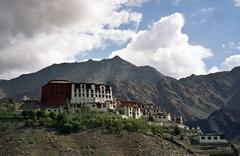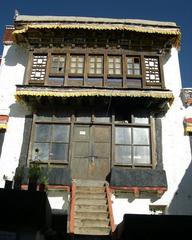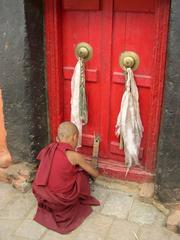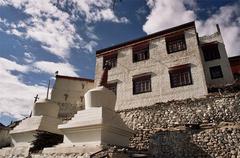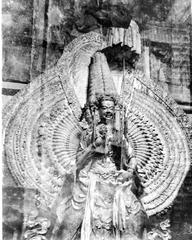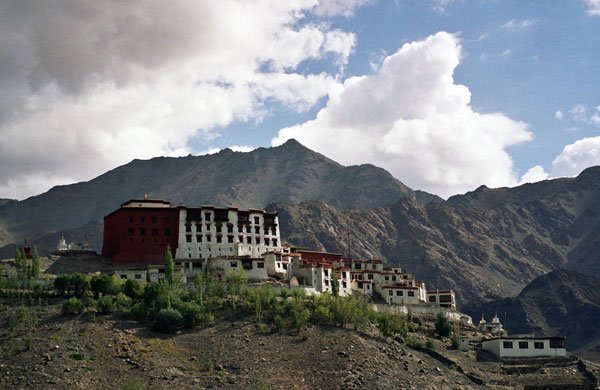
Phyang Monastery Visiting Hours, Tickets, and Historical Significance in Leh, India
Date: 15/06/2025
Introduction to Phyang Monastery: History and Cultural Importance
Phyang Monastery, also known as Gangon Tashi Chodzong or Phyang Gompa, is a prominent center of Tibetan Buddhist culture located approximately 16–20 kilometers west of Leh in Ladakh, India. Perched atop the scenic Gang Ngonpo (Blue Mountain), the monastery is affiliated with the Drikung Kagyu lineage—one of Tibetan Buddhism’s principal schools. Established in the early 16th century by Choje Denma Kunga Drakpa under royal patronage, Phyang Monastery has played a vital role in preserving Ladakhi and Tibetan Buddhist traditions. Its panoramic views of the Indus Valley, ancient murals, thangkas, and a museum housing 900-year-old artifacts provide a unique window into Ladakh’s religious and artistic heritage.
The monastery is not only a spiritual center but also a living hub for meditation, tantric practice, education, and community service. Its most vibrant tradition is the annual Phyang Tsedup Festival, featuring sacred Cham dances, ritual offerings, and the ceremonial unveiling of rare thangkas. This guide offers comprehensive information for visitors, including practical travel tips, visiting hours, ticketing, accessibility, and advice for experiencing the monastery’s spiritual and cultural richness.
For official updates and festival details, consult the following resources:
- [Drikung Kagyu Phyang Monastery](#drikung-kagyu-phyang-monastery)
- [Leh Ladakh Tourism](#leh-ladakh-tourism)
Table of Contents
- Introduction
- Historical Background
- Religious Significance
- Festivals and Rituals
- Cultural Preservation
- Social and Community Functions
- Visitor Information
- Architectural Layout
- Museum and Collections
- Travel Tips and Nearby Attractions
- Phyang Tsedup Festival 2025
- Frequently Asked Questions
- Conclusion
- References and Further Reading
Historical Background
Founding and Early Origins
Phyang Monastery’s origins trace back to 1515 CE, founded by Choje Denma Kunga Drakpa of the Drikung Kagyu tradition, with royal patronage from King Tashi Namgyal. According to local legend, the site was chosen following a visionary experience involving the protectress deity Achi Chokyi Dolma. The monastery’s establishment marked the introduction of the Drikung Kagyu lineage in Ladakh, setting the stage for a flourishing Buddhist tradition.
Drikung Kagyu Lineage and Significance
As the first Drikung Kagyu monastery in Ladakh, Phyang has been integral to the spread of this tradition, emphasizing meditation, tantric practices, and monastic education. The current spiritual leadership is held by Kyabje Togden Rinpoche, the 33rd Drikung Choje of Ladakh.
Architecture and Artistic Heritage
Phyang Monastery exhibits a blend of Ladakhi and Tibetan architectural styles, with whitewashed walls, golden rooftops, and intricately decorated prayer halls. The oldest structure, the Mahakala Temple (Gomkhang), dates to the 16th century and features original protector-deity murals. The monastery’s museum contains artifacts, thangkas, Kashmiri bronzes, and relics from Tibet, China, and Mongolia, reflecting centuries of cultural exchange.
Education and Expansion
Sustained by royal patronage, Phyang Monastery expanded to oversee more than 30 branch institutions. The Ratnashri School within the complex offers a curriculum that balances Buddhist teachings with modern subjects, ensuring the continuity of both spiritual and secular education.
Modern Role and Festivals
Today, Phyang Monastery remains a lively institution with over 100 monks, serving as a center for religious practice, education, and cultural activities. The annual Phyang Tsedup Festival, featuring Cham dances and ritual ceremonies, is a highlight for both locals and visitors.
Religious Significance
Phyang is a major pilgrimage site and a spiritual anchor for Ladakh’s Buddhist community. The monastery upholds key Drikung Kagyu practices—meditation, ritual, and compassionate service—while also providing spiritual guidance for local life events.
The protector deity Achi Chokyi Dolma is especially venerated here for her role in safeguarding the lineage and its followers.
Festivals and Rituals
Phyang Tsedup Festival
The Phyang Tsedup Festival, held annually in July or August (2nd and 3rd days of the 6th Tibetan month), commemorates the Drikung Kagyu founder, Skyoba Jigten Gombo. Highlights include:
- Sacred Cham dances performed by monks in elaborate masks and costumes, symbolizing the victory of good over evil.
- Ritual offerings and the ceremonial destruction of the Storma (effigy) for community purification.
- The grand unveiling of a massive sacred thangka every third year.
Other Rituals
Throughout the year, the monastery hosts additional prayer ceremonies, sacred dances, and public teachings, often open to both Buddhists and respectful non-Buddhist visitors.
Cultural Heritage and Preservation
Phyang Monastery is a guardian of Ladakh’s intangible heritage. Its museum displays ancient scriptures, rare thangkas, Kashmiri bronzes, and ritual objects. The monastery also sustains traditional arts such as thangka painting, calligraphy, and ritual music, serving as a center for artistic and spiritual education.
Social and Community Functions
Beyond its religious activities, Phyang Monastery offers community services including educational support, food distribution, and medical aid. Environmental awareness programs promote respect for Ladakh’s fragile ecosystem.
Visitor Information
Visiting Hours
- Daily: 9:00 AM – 5:00 PM
- Festival Days: Extended hours may apply
Entry Tickets
- Indian Nationals: INR 50
- Foreign Nationals: INR 200
Tickets are available at the entrance; prior booking is not required.
Accessibility
Phyang Monastery is accessible by road from Leh (30–45 minutes by taxi or local bus), followed by a short uphill walk. The main areas are reached via steps and uneven paths, so visitors with mobility challenges should plan accordingly and may request assistance through local operators.
Guided Tours
Guided tours can be arranged at the entrance or in advance through Leh-based travel agencies, enhancing your understanding of the monastery’s history, art, and rituals.
Architectural Layout and Setting
Phyang Monastery’s complex is organized around a central courtyard, surrounded by:
- Main Prayer Halls (Dukhangs): Hosts daily prayers and rituals, adorned with frescoes and statues.
- Shrines: Dedicated to Buddhist figures such as Avalokiteshvara, Maitreya, and Mahakala.
- Monastic Residences: Stone and timber quarters for monks.
- Educational Facilities: Classrooms and libraries.
Artistic Highlights
- Ancient Frescoes: Depicting Buddhist teachings and Drikung Kagyu lineage masters.
- Thangkas and Statues: Intricately crafted, reflecting influences from Tibet, Kashmir, and Central Asia.
- Woodwork and Carvings: Floral motifs and auspicious symbols on pillars and doors.
Museum
The monastery’s museum houses:
- Bronze and clay statues
- Ancient manuscripts and ritual objects
- Ceremonial masks and thangkas
- Historical weapons and relics
Travel Tips and Nearby Attractions
- Best Time to Visit: May–September; July/August for the Phyang Tsedup Festival
- Nearby Sites: Hemis Monastery, Thiksey Monastery, Shey Palace
- Attire: Dress modestly; shoulders and knees should be covered.
- Photography: Allowed in outdoor areas; seek permission before photographing inside prayer halls or the museum.
Phyang Tsedup Festival 2025: Highlights and Practical Guide
Festival Dates and Hours
- Dates: July 22–23, 2025
- Events: 7:00 AM – 5:00 PM (arrive early for best viewing)
- Entry: Free; donations appreciated
Festival Attractions
- Cham Dances: Masked dances by monks, illustrating Buddhist teachings.
- Thangka Unveiling: Display of a massive religious scroll painting.
- Ritual Offerings: Community ceremonies for collective purification.
- Cultural Activities: Traditional music, local food, and crafts.
Travel and Accommodation
- Getting There: 19–20 km from Leh by taxi or local bus.
- Where to Stay: Guesthouses in Phyang village or hotels in Leh (book early during festival season).
- Health Tips: Acclimatize in Leh to avoid altitude sickness; bring sun protection and layered clothing.
Festival Etiquette
- Respect prayer ceremonies and monastic staff instructions.
- Request permission before taking photographs of monks or rituals.
- Maintain a peaceful and silent demeanor in religious spaces.
Frequently Asked Questions (FAQ)
Q: What are the visiting hours of Phyang Monastery?
A: 9:00 AM to 5:00 PM daily; extended hours during festivals.
Q: What is the entry fee?
A: INR 50 for Indian nationals, INR 200 for foreigners.
Q: Is photography allowed?
A: Yes, in most outdoor areas; seek permission inside prayer halls and the museum.
Q: How can I reach Phyang Monastery from Leh?
A: By taxi or local bus (30–45 minutes), followed by a short uphill walk.
Q: Is the monastery accessible for people with disabilities?
A: Accessibility is limited due to the hillside location; assistance can be pre-arranged.
Q: When is the Phyang Tsedup Festival in 2025?
A: July 22–23, 2025.
Conclusion
Phyang Monastery stands as a beacon of Ladakh’s spiritual, artistic, and community life. Its stunning architecture, ancient murals, and vibrant festivals offer visitors a profound and authentic experience of Himalayan Buddhism. Whether you seek spiritual inspiration, cultural immersion, or historical insight, planning a visit to Phyang—especially during the Phyang Tsedup Festival—will be a highlight of your Ladakh journey. For real-time updates, guided experiences, and further resources, download the Audiala app and consult official tourism portals.
Internal Resources
External References
- Drikung Kagyu Phyang Monastery
- Leh Ladakh Tourism
- Ratna Voyages – Phyang Monastery
- Bharat Articles – Festivals of Ladakh
- Trodly – Phyang Monastery
- Phyang Tsedup Festival Details
- Best Time to Visit Phyang Monastery
- Ladakh Events & Festivals Calendar
For enhanced user experience and SEO, include images with alt text such as “Phyang Monastery frescoes,” “Phyang Monastery courtyard,” and “Phyang Tsedup Festival Cham dance.”
